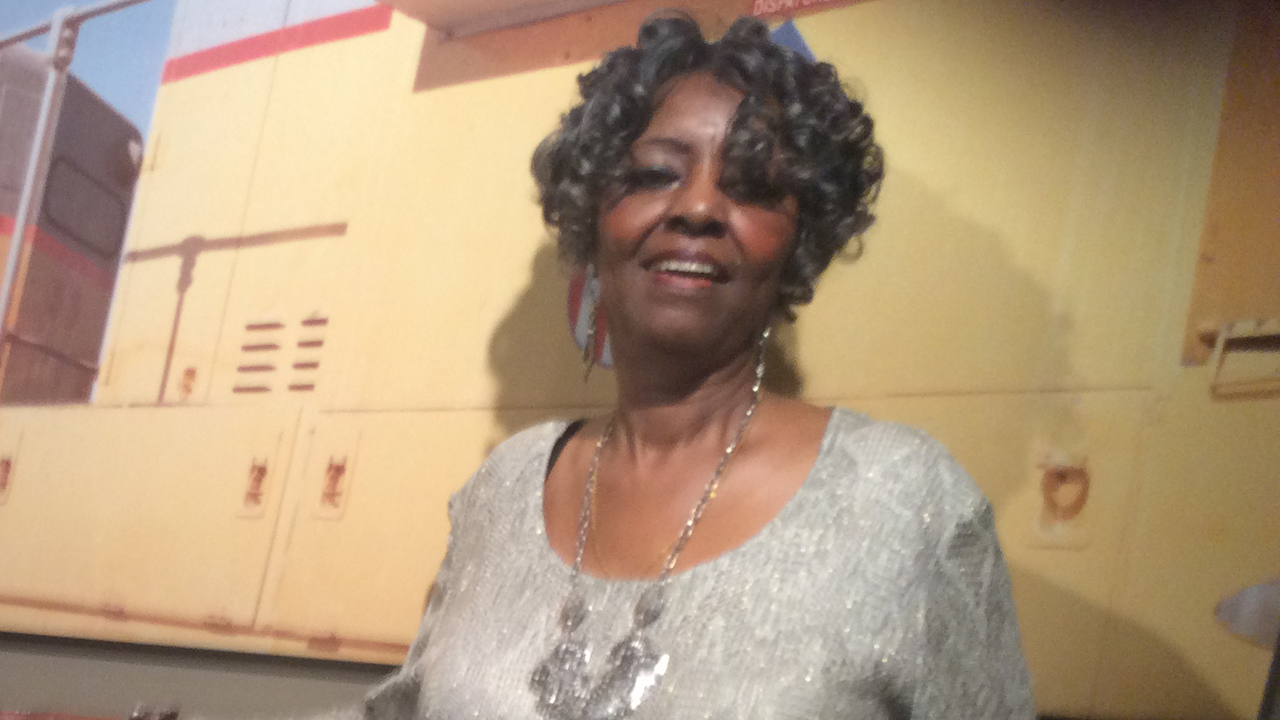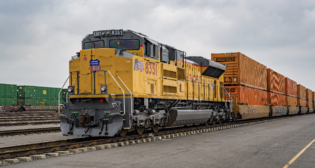
For Justus, Steel Determination
Written by Marybeth Luczak, Executive Editor
At its museum exhibit, “Move Over, Sir!: Women Working on the Railroad,” UP in 2017 celebrated women railroaders, including Edwina “Curlie” Justus, the Class I’s first Black female engineer (pictured). (Photograph Courtesy of Edwina Justus)
“Working at night and going down the track, it’s quiet and all you can hear are the rails, or you’re just sitting there waiting for the signals to change, or it’s sunrise and you see the sun come up—it is almost magical,” says Edwina “Curlie*” Justus of her time in the locomotive cab.
“It’s really funny because I had a teacher who said you’ll never get a job looking out the window,” recalls Justus, who was caught daydreaming at school. “I wish I could say now, ‘Guess what, I got a job and all I did was sit and look out the window.’”
She started at Union Pacific (UP) as a sorter/filer and moved on to become a traction motor clerk, preparing reports for the mechanical department on traction motors taken out of service. “That was my job, but I didn’t know what a traction motor was or what it did,” Justus tells Railway Age. Arrangements were made for her to learn. “So here I am in these high heels and short dress going down to the shop, and they put a white hard hat on my head, and when you wear a white hard hat, that means you’re an official, so all these guys were wondering what I was doing there,” she says with a laugh. She not only received a lesson on traction motors, but also one on operating locomotives. “I got up on the engine and asked, ‘How do you work this thing?’” recalls Justus. Once shown, she said, “‘Oh, heck, well, I could do that!’ And they told me, ‘Well, why don’t you go and put in your application?’” And she did.
“When they called me and told me that I was accepted and that I would be going to North Platte, I cried,” Justus says. “And I called my dad, and my dad said, ‘Take that job.’”
Her husband and kids were in Omaha at that time, and the trip to North Platte was 287 miles by rail, according to Justus. Her husband was also considering a management job in Battle Creek, Mich. But the formidable engineer’s salary and Justus’ father’s confidence in her were among the reasons prompting her to say, “Yes,” though she tells Railway Age she thought she would be running passenger trains, not freight trains.
In 1976, at age 34, she became UP’s first Black female engineer. “When I got hired, it was one of the proudest moments that I’d ever seen him in my life,” Justus says of her father, a service-station owner. “And he would tell anybody he knew that if they were going to North Platte to stop by and see his daughter.”
Taking on the job wasn’t easy, Justus says—not only because there weren’t doors on the bathroom stalls. Back in the day, “if your Daddy worked for the railroad, then you would work for the railroad,” Justus says. “I had all these strikes against me because I was Black, I was female, and I was an outsider. I had a terrible time.”
Following training, including rail yard work, which she disliked, Edwina started local runs—hauling a variety of commodities from livestock to tea. Not all co-workers were helpful. “Some of the guys were doing things like putting ketchup in my shoes, and I was verbally abused once,” she tells Railway Age, noting “that’s the only time that I could ever say that I’ve been bullied. And that didn’t last too long.”
“I tried to get an understanding, in the beginning, you know, I’m not going to bother you, if you don’t bother me,” she tells Railway Age.
“It was funny, because I think I ran a pretty good engine,” says Justus, who adds that later, some of her male co-workers told her that, too. She said the conductors, brakemen and engineers she worked with regularly became “a close-knit” crew.
Food and kindness also helped bring Justus into the fold. “When I was down at headquarters [in Omaha], I was always the one that brought the doughnuts,” she says. (And she made the coffee.) She tells the story of one Valentine’s Day, when she included a card and cookie on each mechanical department official’s desk along with a copy of her traction motor report. “When everyone started coming in, they were looking at me like, ‘Oh, you’re going to get your butt chewed,” since in the office things were done “a certain way,” Justus explains. “They had me scared to death.” But the top official came over to Justus’ desk and said “‘Edwina, it sure is nice to have somebody with a sense of humor.’ And that did it,” she says.
In North Platte, Justus brought a meal with her on trips. At the beginning, “nine times out of 10, one of the guys would steal it,” she says. So Justus started bringing enough to share.
“That was the way I kind of gained respect—I fed them,” she says. “The Bible says feed your enemies.”
Living in North Platte was initially a challenge, as well. It had a population of about 25,000, with fewer than 100 Black people, according to Justus. “It wasn’t that easy to make friends,” she says. And in some small towns during trips, “I would be the only Black woman they’d ever seen,” she tells Railway Age.
Later, Justus’ husband followed her to North Platte; he was hired on as a UP fireman-oiler and elevated to engineer.
Would Justus recommend railroading to today’s young professionals? “Yes, for the experience of it,” she tells Railway Age. “I would probably recommend, especially to women, to go into unconventional things like being an electrician or a plumber. Some of those things aren’t that hard, and you don’t have to have a college education to do them. [Being an engineer] was a good job.”
But to anyone considering the railroading life in addition to having a family, a strong support system is key, she says.
“I enjoyed it when I was out there—the freedom of it,” says Justus, who retired in the 1990s. “I still dream about going to work on the railroad almost every single night.”
“When I first started, I had those incidents, but after that, you know, I kind of made a reputation for myself,” Justus says. “And it was mostly all good.”
For more on Justus and the personal stories of other early women railroaders, read her autobiography Union Pacific Engineer, published by South Platte Press, and Shirley Burman’s Sisters of the Iron Road, published by SBS Publishing.
In a related development, Railway Age’s November 2023 issue celebrated 23 honorees and five honorable mentions for its annual Women in Rail Awards program.
* Where did Justus’ nickname “Curlie” come from? When she was born, her father and grandmother were looking in the hospital nursery at all the babies. Her father thought she was one of the little boys—“plump and big”—Justus tells Railway Age. “My grandmother saw this little curled up baby with curly hair and she said, ‘No, that’s my “Curlie” right there.’ And that nickname has stuck with me.”



